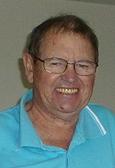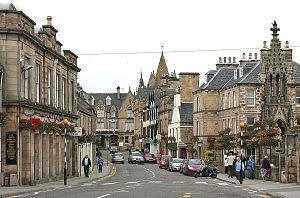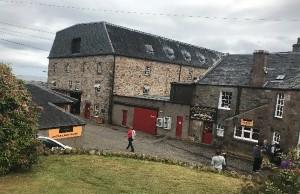August Gathering - 8/10/2017
GENEALOGY ON THE INTERNET
AN INTRODUCTION

Robert M. Wilbanks IV, the CSA’s Chief Genealogist will be presenting a basic beginner's overview to genealogy on the internet.
The presentation will be made on a large screen using PowerPoint and live access to the Internet for an introduction of some of the best online resources.
Bring your own Wi-Fi and hotspot device to explore for yourself along the way.
The Caledonian Society of AZ has regular membership gatherings on the second Thursday of each month, often at the Irish Cultural Center, 1106 N. Central Ave., Phoenix, AZ.
Meetings are open to everyone. Admission is free to Members. Non-member visitors are welcome and asked for a $5.00 donation.
--------------------------------------------------------------------------
Thursday August 10, 2017
Irish Cultural Center, 1106 N. Central Ave., Phoenix
6:30 pm ------------ Mix and Mingle
7:00 pm ------ Genealogy Workshop
8:30 pm ------------ 50/50 Drawing
|
Letter from the Editor, Don Finch
Dear fellow Caledonians:
Short and sweet this month as your Editor and Publisher are on vacation.
Just a reminder that the Caledonian Society’s Chief Genealogist & Historian Robert M. Wilbanks IV is putting on a workshop titled: “Genealogy and the Internet – an Introduction” at our monthly gathering, on Thursday August 10th at the ICC. More details are posted herein.
Also, set aside the afternoon of Sunday September 17th for our “Kilts on Ice” Bonspiel at the Coyote Curling Club in Tempe. Board Member Ian Warrander is organizing this event which will be a challenge to other Scottish groups in the Valley. More details to follow.
Hope you’re enjoying the mysteries, and perhaps, miseries, of summer in Phoenix! One of my favorites is still being able to enjoy hot coffee in your travel cup when coming back to your car several hours later!.
.jpg)
So, See you in September! BTW, does anyone remember the name of the original group that debuted that song in 1966?
The first email I receive with the correct answer wins 2 x one-day tickets to the 2018 Phoenix Sottish Games. Email me at: editor@arizonascots.com
Don Finch, Editor
|
|
Cask Strength vs. Single Malt - & Understanding the Difference
by Eddie Sumpter
Until around 1900, all whisky was consumed at Cask Strength. However, as the market for Scotch whisky grew, so did diverse methods come into play to address the market.
.jpg) Original Cask Strength (or barrel cut) could be as high as 70% alcohol. Obviously not easy to take so would be cut with water or “mak’ye’sikly”. Today most Cask Strength is bottled at around 60%. Depending on the age and “angels share”, this could drop somewhat below the 60% mark. Original Cask Strength (or barrel cut) could be as high as 70% alcohol. Obviously not easy to take so would be cut with water or “mak’ye’sikly”. Today most Cask Strength is bottled at around 60%. Depending on the age and “angels share”, this could drop somewhat below the 60% mark.
Conversely, most Single Malts are bottled at around 40-44% alcohol (or a little higher). Now, what’s in it for the imbiber (or imbibess?)
First off….60% alcohol will only burn your tastebuds (and everything else on the way down) and do nothing for the famous four (sweet,sour,salty and bitter). The aficionados tell us that 35-38% alcohol is the best water/whisky mix for maximum flavor.
The two standards, when water is added, will offer very different sensations. Cask Strength will offer a more complex sensation, having more condensed qualities of the barrel, malting, environment. Expect a full rounded nosing and palate experience.
Matched to a Single Malt of ten to 12 years from the same distillery, the difference will be obvious: Less intense aromas on the nose and a more subtle balance on the palate.
Different barrel choices also come into play (rum,sherry,port,wine). The Single Malt has already been watered to around 60-65% before casking and will not have the same depth of character. Irish Single Malt whisky (triple distilled) and using unmalted as well as malted barley also shows well for flavor intensity.
No bias from this Scot when it comes to whisky.
 Eddie Sumpter lives in Ontario, Canada. Born Glasgow, Scotland, he emigrated to Canada in 1965. Eddie retired after 25 years of sales to the Graphic Arts industry, president of a graphics media company and sales consultant, cashier, sawmill operator, forklift operator, floor sweeper in a big box store after. Eddie Sumpter lives in Ontario, Canada. Born Glasgow, Scotland, he emigrated to Canada in 1965. Eddie retired after 25 years of sales to the Graphic Arts industry, president of a graphics media company and sales consultant, cashier, sawmill operator, forklift operator, floor sweeper in a big box store after.
His interests include sailing, power boating, fishing, golf, pickleball, poetry writing and hosting whisky tasting evenings.
Eddie says that he loves winters in AZ and will be coming ‘til the money runs out.
|
|
Research Your Scottish Ancestry
More Internet Genealogy
 by Robert M. Wilbanks IV, B.A. by Robert M. Wilbanks IV, B.A.
Chief Genealogist & Historian, C.S.A.
genealogy@arizonascots.com
With the advent of the Internet, very techie genealogists were quick to utilize this medium for the creation of sites for the exchange of information, education, resources and even forums for discussion. The number of resources accessible to genealogists significantly grew and today it is one of the most popular topics on the Internet.
In today’s high-tech age, the internet is now a rich extensive research tool for genealogists any time, access day or night, from anywhere. Libraries, records centers, and archives are making historic records more freely accessible on the internet. Additionally, many free websites have been created by genealogists, genealogical organizations, local history societies, heritage groups, and more.
The last two articles discussed a few significant subscriptions based websites, and a major free website, with extensive resources and ability to build your family genealogy and history on the same site. Here, in advance of this months “Genealogy Workshop” for our monthly meeting, I will introduce you to, with a preliminary overview, a few of the different and most notable genealogy websites on the Internet. These are mostly all free genealogy websites built by volunteer genealogists.
USGenWeb – www.usgenweb.com – is a site of links to information and networking, organized by the states and counties in the United States. You can find information as to what records are available by state or county, who to contact, what organizations exist, history and sometimes project transcriptions of specific records for states, counties and some cities.
Rootsweb – www.rootsweb.com – is a great website for beginners. A free web-based genealogy community that offers general genealogy information, research tips, etc., and also has some databases to search and links to many other specific subject web sites. Several databases include uploaded genealogy databases, links to mailing lists, message boards and how to connect or access archives of previous postings. Also you will find links to many genealogy websites that are hosted for free by Rootsweb; and you can create your own genealogy site for free.
Genealogy.com – www.genealogy.com – is a website that mostly offers instructional information, general genealogy information, research tips, message boards and forums and other networking portals. It also allows you to personalize this site for your own genealogy needs and activities, including downloading and creating your genealogy pedigree.
GenForum – genforum.genealogy.com – a component of Genealogy.com, it is a conglomeration of Message Boards on various surnames, locations and topics. A great place to learn and ask questions.
U.S. Ports of Arrival – www.genesearch.com/ports.html - lists many United States sea ports and land border ports, identifying known extant and/or published immigration records (passenger arrival lists) 1820-1957, organized by state. Includes Canadian and Mexican border crossing records. Find info on ship passenger arrival records (and a select few for airplane passenger lists). Crew lists, a few passenger departure records, and some passenger arrivals after 1957, are also included. U.S. Territories are listed at the end. Other links are included.
Castle Garden – www.castlegarden.org – is an educational project of The Battery Conservancy. This free site offers access to an extraordinary database on 11 million immigrants from 1820 through 1892. More than 100 million Americans can trace their ancestors to this early immigration port and period.
Ellis Island – www.libertyellisfoundation.org – The Ellis Island Archive contains passenger lists of over 51 million immigrants, passengers, and crew members who came through Ellis Island and the Port of New York from 1892 to 1957. The period 1892 to 1924 at Ellis Island was the largest human migration in modern history! The expansion of this database of Port of New York arrivals is continuing. All records from 1925 through 1957 should now be searchable.
WorldGenWeb – www.worldgenweb.org – is the world-wide equivalent of the USGenWeb site. Here is the link for the page specific for Ireland and the United Kingdom GenWeb – www.iukgenweb.org and here is the specific link for ScotlandGenWeb – www.scotlandgenweb.org
FreeUKGenealogy – www.freeukgenealogy.org.uk – is a UK site dedicated to Open Data and Open Source access to information and records for genealogy. Teams of volunteers create high quality transcriptions of public records from government and various sources. Here you will find over 333 million births, marriages and deaths, 38 million parish register entries, and 32 million individuals from the 1841 to 1891 census. Completely free to search and view.
RootsUK – www.rootsuk.com – is a semi-free site: free searches are available but there is a fee to access records. You must register as a user. Roots UK offers you the ability to search through multiple databases with one click, so you can find and access likely entries quickly. They have birth, marriage and death index for England & Wales from 1837-2005, census transcripts for selected counties 1841-1891.
GENUKI – www.genuki.org.uk– provides a virtual reference library of genealogical information of particular relevance to the UK and Ireland.
Cyndi’s List – www.cyndislist.com – is the most notable resource guide for most all known genealogy related websites on the Internet. This website organizes and categorizes genealogy websites by subject, etc. Example: from “Categories” scroll to “United Kingdom & Ireland” then click on "Scotland" for a list of links on genealogy web sites related to research in Scotland. On Cyndi’s List you can also find extensive links to specific surnames, or learn about Military records, Church records, Passenger lists, etc.
The above are only a few of the vast number of genealogy sites on the internet. Please be advised that as with anything else on the internet, genealogy information found on the internet must always be verified for accuracy through original research and resources, detailed evaluation and analysis, etc.
For the August 10 meeting, be sure to bring your online device, and your own hotspot, so that you may explore these and many other genealogy sites.
This is another of a series of articles in which I show you the basics of searching for your family history, discussing the use of family records, public records, and online resources nationally and internationally, etc. The previous articles are now available on the Genealogy Section of this website. See “Genealogy” in the menu options at the top of the web page. |
|
Whisky Galore
by Don Finch
|
On my recent visit to Scotland I was able to visit the birthplace of two of my favorite malts, Glenmorangie and Highland Park.
 Glenmorangie is located in the royal burgh of Tain, 34 miles north of Inverness - definitely in the Highlands.The earliest record of production of alcohol at Morangie Farm is dated 1703 and in the 1730’s a brewery was built on the site that shared the farm's water source, the Tarlogie Spring. In 1843, it was converted to a distillery and renamed Glenmorangie Glenmorangie is located in the royal burgh of Tain, 34 miles north of Inverness - definitely in the Highlands.The earliest record of production of alcohol at Morangie Farm is dated 1703 and in the 1730’s a brewery was built on the site that shared the farm's water source, the Tarlogie Spring. In 1843, it was converted to a distillery and renamed Glenmorangie
 After touring the buildings where the multiple steps to produce one of the world’s finest single malts occur, I was able to meet with Annette MacKenzie, from the local management group. To show the Society’s appreciation of their past sponsorship of the Phoenix Scottish Games, I presented her with several of our souvenir items as well as a member lapel pin. After touring the buildings where the multiple steps to produce one of the world’s finest single malts occur, I was able to meet with Annette MacKenzie, from the local management group. To show the Society’s appreciation of their past sponsorship of the Phoenix Scottish Games, I presented her with several of our souvenir items as well as a member lapel pin.
Ever the gracious host, she arranged a private tasting of their four main products: The Original 10 yr.; The Lasanta 12 yr. sherry casks; Quinta Reuben 12 yr. port casks; and Nectar D’or 12 yrs., the final 2 in sauterne wine barriques.
.jpg) .jpg)
My favorite? It’s hard to beat The Original (the busiest spot on my bar!), but sipping a large dram of the Quinta Reuben, gazing through a window which overlooked the hundreds years old cut-stone aging warehouses, with Dornnoch Firth yonder was a pretty nice way to end my afternoon!
Highland Park is in Kirkwall which is the largest town and capital of the Orkney Islands. It’s on roughly the same latitude as Oslo, Norway which, incidentally was where the original settlers of the Orkneys came from. I learned that school kids visit Norway almost as often as Edinburgh or Glasgow. And the Orkney flag seems to still show some allegiance to its eastern neighbor.
|
| 
Scotland flag |
| 
Orkney flag |
| 
Norway flag |
|
Back to the whisky! Highland Park’s output is less than half the production of Glenmorangie’s 6 million liters per year. The distillery is even older, beginning its life in 1798. Following the tour which pointed out several differences involving the malting process, the type of peat used to dry the barley, and the size and height of the stills, we moved on to the tasting room. The guides passed a tray of pre-poured drams of their 12 yr. which is one of my favorites. Whisky expert Michael Jackson calls it “the greatest all-rounder in the world of malt whisky”. Then our small group was treated to a new release of a cask-strength special edition, only commercially available in Asia. I believe it was about 60 proof, vs the 12 years’ 43 proof.
.jpg) .jpg)
After nosing it and taking a sip, it made a statement! There were a lot of “whew!” comments, and throat clearing – it really was too strong to enjoy. But then, with some highland spring water added to significantly reduce the alcohol content, it was reminiscent of a heathery, smoky, honeyed, and smooth cognac.
Amongst that small fraternity of distillery tour-istas, Highland Park is at the top of everyone’s list. Their process is different in that they still have a malting room where the grain is hand-turned. The soil over the peat is covered in heather, the maturing warehouses are constantly cool due to Orkney’s northern latitude and North Sea proximity, and all the whisky is aged in sherry oak casks. Maybe what the youthful tour guides say is true; that Highland Park is the best whisky in the world!
|
|
Scottish History - Holyrood Abbey
by Jo Ramsdell
Holyrood Abbey is a ruined abbey of the Canons Regular in Edinburgh. The abbey was founded in 1128 by King David I. During the 15th century the abbey guesthouse was developed into a royal residence and after the Scottish Reformation the Palace of Holyroodhouse was expanded further. The abbey church was used as a parish church until the 17th century and has been ruined since the 18th century. The remaining walls of the abbey lie adjacent to the palace, at the eastern end of Edinburgh’s Royal Mile. The site is now protected as a scheduled monument.
Rood is an old word for the cross which Jesus was crucified upon; thus the name Holyrood is equivalent to “Holy Cross”.

Photo: Mark Pelletier, 2015
Legend relates that in 1127, while King David I was hunting in the forests to the east of Edinburgh during the Feast of the Cross, he was thrown from his horse after it had been startled by a stag. According to variations of the story, the king was saved from being gored by the charging animal when it was startled either by the miraculous appearance of a holy cross descending from the skies, or by sunlight reflected from a crucifix which suddenly appeared between the stag’s antlers while the king attempted to grasp them in self defence. As an act of thanksgiving for his escape, David founded the abbey on the site in 1128.
Among the chief benefactors of Holyrood during the four centuries of its existence as a religious house were Kings David I and II, Robert, Bishop of St. Andrews, and Fergus, Lord of Galloway. The Parliament of Scotland met at the abbey in 1256, 1285, 1327, 1366, 1384, 1389 and 1410. In 1326 Robert the Bruce held parliament there and there is evidence that Holyrood was being used as a royal residence by 1329. The abbey’s position close to Edinburgh Castle meant that it was often visited by Scottish kings. In the mid-15th century, with the emergence of Edinburgh as the main seat of the royal court and the chief city in the kingdom, the kings of Scotland increasingly used the accommodation of Holyrood for secular purposes. James II was born there in October 1430 and was also crowned there.
In 1633 the abbey was extensively remodeled for the coronation of Charles I. Then in 1686 James VII established a Jesuit college within Holyrood Palace. The abbey has been the site of numerous royal weddings—these include James II and Mary of Guelders in 1449, James III and Margaret of Denmark in 1469, and James IV and Margaret Tudor in 1503. Many royal interment occurred at the abbey: King David II in 1371, King James II in 1460, Mary of Guelders in 1463, King James V in 1542, and Henry Stuart, Lord Darnley in 1567.
Holyrood Abbey is listed in “The United Kingdom’s Oldest Buildings” having been built shortly after St. Margaret’s Chapel in Edinburgh Castle (1124) and St. Andrew’s Church (1125).
|
|
FUTURE SOCIETY GATHERINGS FOR 2017
Month |
Date |
Location |
Program |
AUGUST |
Thursday 10th |
ICC |
Genealogy Presentation |
SEPTEMBER |
Sunday 17th |
Tempe |
Kilts on Ice Curling Bonspiel |
OCTOBER |
Thursday 12th |
Glendale |
ScotsToberfest and AGM |
NOVEMBER |
Thursday 9th |
TBA |
TBA |
NOVEMBER |
Sunday 12th |
Mesa |
RAF Memorial, Mesa City Cemetery |
DECEMBER |
Thursday 14th |
ICC |
Annual Family Christmas Party |
|
|
Membership Renewal Reminder
Dues are still only $25 Single and $40 Family. This admits you to all our wonderful monthly events with food and entertainment provided. Payments received in November or December of 2016 include full year membership for 2017.
It’s easy to pay by credit card at our On-Line Shopping Cart - just jump to the Membership Page
Society Gatherings
Regular membership gatherings are usually held the second
Thursday of each month at the Irish Cultural Center,
1106 N. Central Ave., Phoenix, AZ. beginning at
6:30 pm. Please check our website for further details.
|
|
Caledonian Society Officers
|
|
|